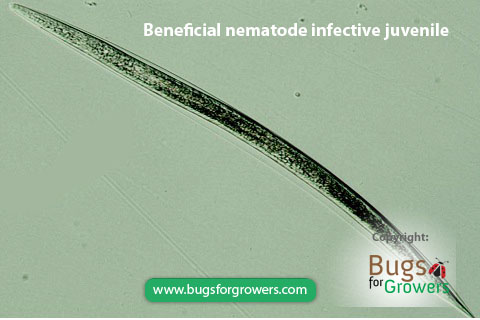Two entomopathogenic bacteria, Xenorhabdus bovienii and Photorhabdus luminescens
The bacteria that are symbiotically associated with the beneficial entomopathogenic nematodes are called as entomopathogenic bacteria. In this mutualistic relationship, both bacteria and nematodes depend on each other for their reproduction, development and survival. As entompathogenic bacteria do not live freely in the nature, they have to depend on the nematodes for their survival in the nematode’s gut and, also, for carrying them inside the insect host body and releasing in the insect blood (also called haemolymph) where bacteria can develop and multiply. Entomopathogenic nematodes on the other hand depend on these bacteria for killing their insect hosts as well as food.
Briefly, the infective juveniles of beneficial entomopathogenic nematodes (Photo 1) that live in the soil always carry a few entomopathogenic bacterial cells in their guts or in special pouches. In the soil, infective juveniles of different species of beneficial nematodes use different foraging strategies including “ambush” (sit-and-wait), “cruise” (moving throughout soil profile) and “intermediate (both ambush and cruise strategies) for searching their insect hosts. When infective juvenile nematodes find their insect host, they generally enter into host body through natural openings like anus, mouth and spiracles. Once inside the insect body, infective juveniles release bacterial cells through their anus in the insect blood where bacteria multiply, cause septicemia and kill insect hosts within 48 hours.

Inside the dead insects (cadavers), 3rd stage infective juvenile (also called daure juvenile) nematodes recover by shedding off their second stage cuticle and begin feeding on multiplying bacteria. While feeding on bacteria, nematodes develop, reproduce and complete 2-3 generations. Then after depletion of food (when bacteria stop multiplying), nematodes exit cadavers as infective juveniles in the soil. These exiting infective juveniles make sure that they are carrying a few bacterial cells in their guts to use them as weapon to kill the new host. Inside the insect cadaver, multiplying bacteria also produce several different kinds of metabolites/antibiotics with bactericidal, fungicidal and nematicidal properties to preserve cadavers from decomposition (Webster et al., 2001).
Entomopathogenic bacteria belong to two major genera such as Xenorhabdus and Photorhabdus in the family Enterobacteriocae. Most of the species of Xenorhabdus and Photorhabdus are generally associated with Steinernematid and Heterorhabditid nematodes, respectively. Each of the species of these two genera is generally symbiotically associated with a specific species of entomopathogenic nematodes. For example, Xenorhabdus bovienii, Xenorhabdus nematophilus and Photorhabdus luminescens bacteria are associated with a beneficial entomopthogenic nematode species called Steinernema feltiae, Steinernema carpocapsae and Heterorhabditis bacteriophora, respectively.
It is a well-known fact that this entomopathogenic nematode-bacteria complex can kill a wide variety of their insect hosts within 48 hours after infection. However, entomopathogenic nematodes without their bacterial partner are less effective in killing their host insects and bacteria even cannot kill their insect hosts unless they are introduced into insect body through injections or infective juveniles. Further more, nematodes with or without entomopathogenic bacteria cannot kill disease causing plant pathogens but different kinds of metabolites produced by laboratory cultured entomopathogenic bacteria in broth can kill a wide range of disease causing plant pathogens. For example, recent studies conducted by Shapiro-Ilan et al (2014) showed that broth containing different kinds of metabolites collected from two entomopathogenic bacteria, Xenorhabdus bovienii and Photorhabdus luminescens suppressed the intensity of pecan diseases caused by Fusicladium effusum and Phytophthora cactorum and peach disease caused by Armillaria luminescens.
For detail information on the interaction between entomopathogenic bacteria and plant pathogens, please read following research papers.
- Shapiro-Ilan, D.I., Bock, C.H. and Hotchkiss, M.W. 2014. Suppression of pecan and peach pathogens on different substrates using Xenorhabdus bovienii and Photorhabdus luminescens. Biological Control 77: 1-6.
- Webster, J.M., Chen, G., Hu, K and Li, J. 2001. Bacterial metabolites. In: Entomopathogenic Nematodes. (ed. Gaugler, R.). CABI Publishing, NY. pp 99-113.
